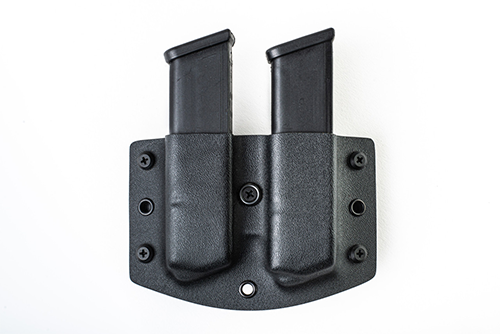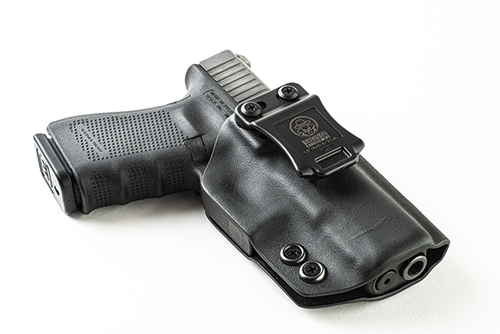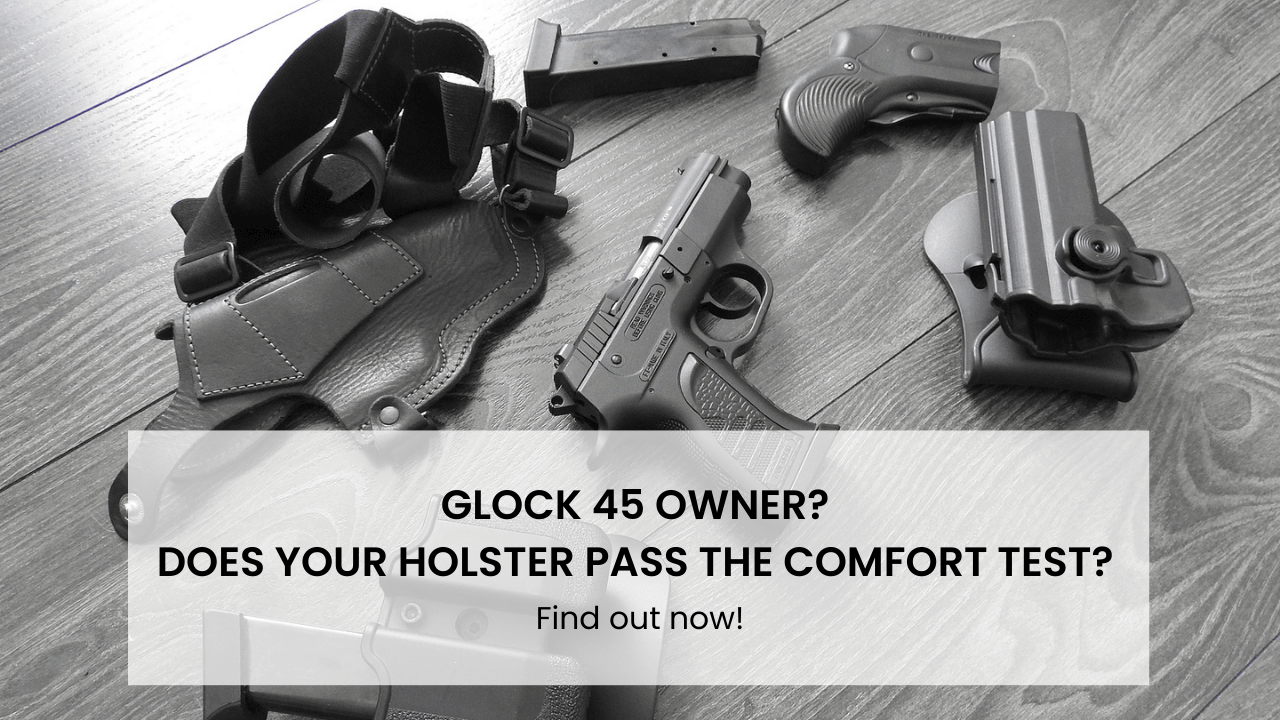6 Must-Know Tips For 1911 Concealed Carry Holster
Sep 20th 2022

The 1911 is one of the quintessential American pistol platforms designed by legendary firearm inventor John Moses Browning and first adopted by the U.S. military in 1911. Although it was phased out of military service by the Beretta M9 in 1985, the 1911 and its derivatives continue enjoying immense popularity among civilian shooters, from self-defense to competition shooting.
Although the original 1911 is a large, heavy, full-sized pistol platform chambered in .45 ACP, many shooters favor it even for concealed carrying due to its slim profile, light trigger, and the stopping power of its original chambering. However, it isn’t the easiest pistol to carry, let alone conceal effectively.
Here are six tips for shooters interested in concealed-carrying America’s favorite .45-caliber semi-automatic.
Wear a Robust Gun Belt
As the 1911 was designed long before the era of lightweight alloys and plastic polymers, full-size 1911 pistols employ a significant amount of steel in their construction.
For example, standard full-size 1911 pistols like the Colt M1911A1 are 8.5 inches long, feature 5-inch barrels, and weigh 39 ounces (about 2.4 lbs.) unloaded. In other words, they are large and relatively heavy.
Consequently, a gun owner looking to conceal-carry the 1911 must choose a gun belt that can support that weight without issues. Do not rely on standard dress belts, which have neither the durability to withstand this kind of weight without tearing nor the ability to retain its shape and prevent your pants from sagging.
Instead, pick a belt explicitly designed for carrying guns, such as the Incognito Concealment 1.5” Hybrid EDC Belt. This gun belt features high-durability dual-layer nylon webbing and an industry gold-standard Cobra belt buckle, ideal for everyday carry.
Use a Dedicated Holster
Although 1911 pistols are well-known for being large and heavy handguns, they are also single stack handguns, meaning the cartridges are stacked one over the other inside the magazine. In contrast, a Glock 17 is double stack, with the cartridges sitting in a staggered fashion, appearing to form two columns.
While double stack handguns have the advantage of capacity, single stack pistols like the 1911 don’t need thick frames to accommodate the magazine, making them slimmer and easier to conceal. This characteristic opens more concealed carry holster possibilities for gun owners looking to carry the iconic Colt .45 pistol.
Fortunately, you don’t need to use a vintage wartime 1911 leather holster or a 1980s-era shoulder holster to carry your favorite handgun. Modern, high-quality Colt 1911 holsters are available and suit various carry styles and positions.
IWB Carry
If you prefer IWB carry, consider using the Incognito Concealment T3 belt holster for your Colt 1911. This concealment gun holster is made of Kydex, a high-durability, non-deforming thermoplastic material specifically molded to match the shape of your handgun.
The 1911 version of the T3 holster fits all full-size 1911 pistols, from military vintage models to modern clones like the SIG Sauer 1911 STX.
OWB Carry
Concealed carrying with an OWB holster is not only possible; it is an excellent solution for 1911 owners as long as you use the right holster type.
If you prefer this carry method for concealment, avoid security or high-retention holsters (e.g., thumb break, auto-locking devices) and use a dedicated, low-profile concealment holster like the Incognito Venture. The Venture is manufactured using thin Kydex sheets (0.08” thick), ensuring long-lasting durability while minimizing printing.
Get Used to Firearm Maintenance
Carrying a 1911 is a little like driving a classic muscle car. While the idea is desirable to many, it requires discipline and knowledge to do so reliably and competently. Just as you should learn to take care of a classic car before driving it on the roads, it is crucial to learn how to care for and maintain the 1911 pistol before carrying it on the field.
Maintenance is doubly crucial if you intend to carry your 1911 pistol in a concealment holster. Concealed carrying exposes your gun to sweat, heat, lint, and all kinds of grime and contaminants (e.g., dust, lint, etc.). These conditions can ruin your handgun’s finish and reduce its reliability, potentially endangering your life in a self-defense scenario.
Learn how to field-strip your handgun, purchase appropriate cleaning tools and materials, and clean it according to your manufacturer’s recommendations. Perform routine cleaning at least once a month or every 300 to 500 rounds, depending on your preferences and shooting frequency.

Consider Carrying Extra Magazines
The standard 1911 magazine in .45 ACP models is single-stack and carries a maximum of 7 or 8 rounds. Although single stack 1911 magazines with a capacity of 10 rounds or more exist, they are long and unwieldy, making them unsuitable for concealed carrying.
A fully-loaded, full-size 1911 chambered in .45 ACP contains 8 or 9 rounds at most, which can be rapidly expended during a gunfight. For this reason, many 1911 owners carry additional spare magazines, often 2 or more.
A popular concealed carry configuration is the double magazine carrier worn in a cross-draw position (opposite the gun on the belt). When paired with a full-size .45 ACP Colt 1911 pistol and modern 8-round magazines, this setup lets you carry up to 25 rounds of ammunition: 9 in the gun plus 8 in each of the two spare magazines.
Learn to Carry Cocked and Locked
One of the unique particularities of the 1911 pistol design is its action. Unlike most modern semi-automatic pistols, the 1911’s is a hammer-fired, single action only (SAO) firearm.
Single action means the hammer must be cocked before you can pull the trigger and fire. While single action triggers are well-known for being light and crisp, undisciplined shooters are at significant risk of a negligent discharge due to the 1911 lacking a double-action mode or a Glock-style trigger-mounted safety.
However, the 1911 pistol is equipped with a manual safety lever, traditionally located on the left side of the frame. Learning to load it and use the safety lever correctly is an essential aspect of owning and carrying a 1911 pistol.
Legendary firearms expert Jeff Cooper designed the Condition of Readiness system to help 1911 shooters identify the different possible states a 1911 can have and choose the one they find safest for their skill level.
Under Cooper’s system, you can carry a 1911 pistol in one of five possible states, numbered from 4 (Condition Four) to 0 (Condition Zero).
Condition Four
A 1911 pistol in Condition Four has no magazine inserted, no round in the chamber, and the hammer is down.
It is the safest possible state a handgun can reach, such as during transportation in a range environment. However, it is not recommended to intentionally carry a concealed 1911 in Condition Four, as the weapon is completely empty and unable to fire.
Condition Three
Condition Three means magazine inserted, no round in the chamber, hammer down.
Although Condition Three is the safest condition for concealed-carrying a 1911, it is not recommended, as your gun is not ready to fire until the slide has been racked to chamber a round.
If you wish to carry your 1911 Condition Three, consider learning specialized drawing techniques that incorporate slide racking into the draw stroke, such as the Israeli Draw.
Condition Two
Condition Two means magazine inserted, round in the chamber, hammer down.
Theoretically, a 1911 in Condition Two can be rendered ready to fire with one hand simply by thumbing the hammer down.
However, setting a loaded 1911 to Condition Two requires significant discipline and is potentially dangerous. To reach Condition Two, you must rack the slide on a loaded magazine to load a cartridge in the chamber, then carefully pull the trigger while holding the hammer with your thumb, slowly lowering it to the down position.
A mistake during the lowering process can result in an unintentional discharge. Due to the extreme safety risks involved with setting a 1911 to Condition Two, it is not recommended, regardless of your skill level.
Condition One (Cocked & Locked)
Condition One means magazine inserted, round in the chamber, hammer cocked, safety engaged. If you intend to conceal-carry a 1911, Condition One is the recommended state of readiness.
Jeff Cooper considered Condition One the highest level of readiness that is still safe for carrying. Condition One also lets you use the 1911’s full capacity (loaded magazine + 1 in the chamber).
Although the hammer is visibly cocked and a round is in the chamber, the manual safety prevents the shooter from pulling the trigger, significantly reducing the risk of a negligent discharge.
Condition Zero
Condition Zero means magazine inserted, round in the chamber, hammer cocked, safety off.
This level of readiness means “Ready to fire.” On a 1911, the only difference between Condition One and Zero is the position of the safety lever. You should only enter Condition Zero when aiming at the target.
Practice, Practice, Practice
Owning and shooting a 1911 requires learning many 1911-specific techniques and information.
If you’re going to carry a 1911 concealed, it is critical to practice as much as possible, especially if you are a beginner shooter or aren’t yet used to 1911 platforms.
Incognito Concealment Holsters: As Dependable and Practical as the 1911
Incognito Concealment carries a selection of IWB and OWB Kydex holsters suitable for everyday concealed carrying. Our 100% American-designed Kydex holsters are ideal for carrying any handgun, from subcompacts to full-size models such as the 1911. For more information, contact us at (586) 333-4240.











